

La maison en bois BBC pour les auto constructeurs. La maison en bois à la portée de tous. Et si la maison en bois détrônait la maison en parpaing ?
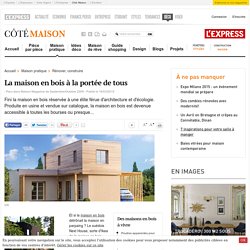
Le suédois Next House, sorte d'Ikea de la maison en bois, proposera dès cet automne un catalogue de dix modèles contemporains prêts à habiter, à un prix défiant toute concurrence : moins de 100 000 € HT pour 95 m2 avec terrasses (ce prix ne comprend pas le terrain, la TVA, le transport et le montage). Son secret ? Une livraison en kit, les maisons étant préfabriquées en Suède avant d'être transportées par camion et assemblées sur place en quelques jours par une équipe dédiée. Il faut dire que le marché français est une aubaine pour le constructeur scandinave : ici, les maisons à ossature bois (MOB) représentent à peine 7 % des constructions, contre 30 % en Allemagne et 90 % aux États-Unis. 1/3 des ménages intéressés par les maisons en bois Assemblée comme un Lego.
Montainer Shipping Container Homes Ready to Order. The Missoula, Montana bases company Montainer has begun selling the first prefabricated model of the shipping container homes they offer.
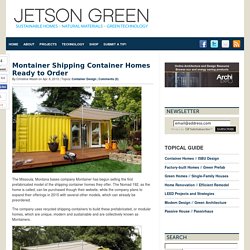
The Nomad 192, as the home is called, can be purchased though their website, while the company plans to expand their offerings in 2015 with several other models, which can already be preordered. The company uses recycled shipping containers to build these prefabricated, or modular homes, which are unique, modern and sustainable and are collectively known as Montainers. Sustainable Modular Home Designs Australia. Cubicco - Inspiring conscious living - How we do it. Forward Evolution Longevity, strength and efficiency are the elements that inspire our vision to deliver comfort and harmony in an ever changing environment.
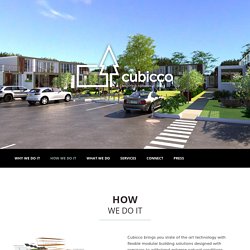
Axiom Series - Turkel Design. Since 2005, Joel Turkel and Turkel Design have been Dwell's lead architectural partners in creating prefabricated homes that embody Dwell's vision of modern design.
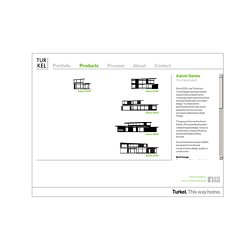
To celebrate the partnership's tenth year, we are pleased to announce a new exclusive collaboration: Dwell Prefab. This group of homes, the Axiom Series, offers a panelized system celebrating bold design, resource conservation, energy efficiency, and a predictable building process. Axiom Series homes start at $250 per square foot and never compromise on design, quality or construction. Bold Design A home should be beautiful to look at and a joy to live in. Each Axiom home reflects intuitively-designed living space and uncompromising attention to detail. Resource Conservation A home should use minimal material and energy to create. Prefab Spotlight: Turkel Design. How would you describe the state of prefab overall?
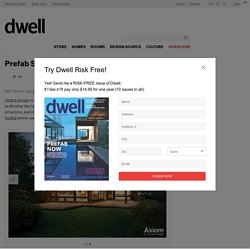
It's inundated with architects who are trying to architecturalize the problem; they want the issue of prefab to be an architecture problem. It's like the saying When you have a hammer in your hand, everything looks like a nail. It's much more about the delivery mechanism though: When you walk out the door as a consumer to buy a house, what are all the things required for you to turn the key in the door and walk into the house? Small, Green, and Mighty: Hurricane-Proof Prefab. When it comes to building sustainably, it requires more than slapping a solar array on a house.
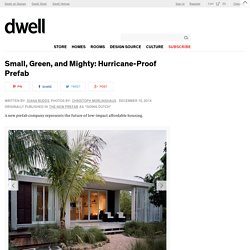
Cubicco—a Dutch prefab company that opened an office and a manufacturing facility in Miami, Florida, in August 2013—takes a holistic approach to responsible residential architecture. “We ought to construct homes that are built around social and environmental needs with a design that’s beautiful, functional, and within reach,” Randy Riteco, Cubicco’s founder, says. Structural resiliency and longevity were of paramount importance to Riteco. ViVood: Tiny Pop-Up Wooden Home From Spain Comes With Built-in Solar Panels. A group of Spanish architects and engineers joined forces to create ViVood - a tiny wooden prefab home.
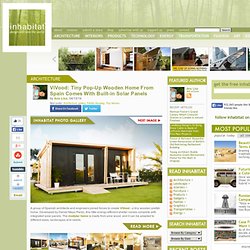
Developed by Daniel Mayo Pardo, this little energy-efficient shelter comes complete with integrated solar panels. The modular home is made from pine wood, and it can be adapted to different sizes, landscapes and needs. ViVood was designed and manufactured in Spain using local materials and labor. Its technologically advanced design allows for easy mass production, and therefore lower costs. Its roof and walls pop-up from its wooden base, which comes with adjustable legs that can adapt to any terrain. The energy-efficient home uses both passive and active strategies to reduce its footprint. . + ViVood Via Plataforma Arquitectura Photos by ViVood. ViVood: Tiny Pop-Up Wooden Home From Spain Comes With Built-in Solar Panels. The affordable passive house, assembling polystyrene blocks PSE separated by wooden boards. Cabanas no Rio by Aires Mateus.
Lisbon studio Aires Mateus used only reclaimed timber to construct this pair of waterfront cabins in Grândola, Portugal (+ slideshow).

An Economical Modular Prefab in Oregon. Bronx Box « Resolution: 4 Architecture. Completion Date: 2008 Size: 1,816 sf Typology Series: Single Bar Modules: 2 Boxes, Panelized Saddlebag & Stair Bulkhead Program: Bedrooms: 2 Baths: 2.5 Features: Roof Deck, Balcony Deck Materials: Exterior: Galvalume Metal Roof, Cement Board, Cedar Siding, Ipe Wood Decking Interior: Maple Cabinets, Bamboo Floors, Slate Bathroom Floors, Caesarstone Countertops Project Description: This urban infill prefab is located at the foot of the Throgs Neck Bridge on Eastchester Bay in the Bronx.
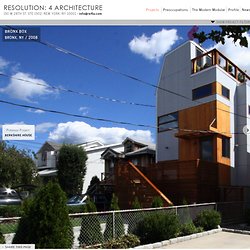
The Bronx Box is a modified version of the double-decker, 2-story bar typology with an additional storage ‘saddle bag’, containing built in cabinets along the length of the house. A Compact Prefab Vacation Home. Every summer for over a decade, Andrew and Shiree Morrison have journeyed to Onemana, a coastal town on New Zealand’s North Island.

They used to stay in a small trailer, often fantasizing about building a house on their sloping plot of land but always coming up short on the amount of money needed to get a project underway. So their longtime friend, builder John Cocks, suggested an unconventional solution to obtaining a custom home within their budget: collaborating with architecture students. The topography proved challenging so the designers elevated the house on piers. At Auckland’s Unitec Institute of Technology, Dave Strachan leads a program called Studio 19. The year- long class guides students through every step of a real-world architectural project, from client brief to full-scale build. The Morrisons wanted something modest in size, modest in price, and visually distinctive from other houses in the neighborhood.
The 807-square-foot house is an exercise in subtleties. Commod house.